2019 sales of electric vehicles in the US decreased 7% to 9% versus very strong sales growth in 2018, according to separate estimates from Edmunds and InsideEVs.
325,000 EVs (both BEV and PHEV) were sold in 2019 in the US according to an estimate from Edmunds released in a Los Angles Times article. This is a decrease of 6.88% from 349,000 units sold in 2018.
InsideEVs, which tracks EV sales through its Sales Scorecard, estimates 329,528 EV units were sold in 2019, roughly 4,500 more than Edmund’s estimate and a decrease of 8.88% versus the higher 361,307 InsideEVs estimated for 2018.
The Alliance of Automobile Manufacturers, however, which publishes actual vehicle registrations using data from IHS Markit, lists a much lower 328,818 EVs sold in 2018. The Alliance updates its Advanced Technology Vehicle Sales Dashboard every few months with sales data that is typically only through about 4 months prior to the current date. The current data is updated through June of 2019 and so full-year 2019 data (now supplied by Hedges & Co.) is not expected until perhaps April or May.
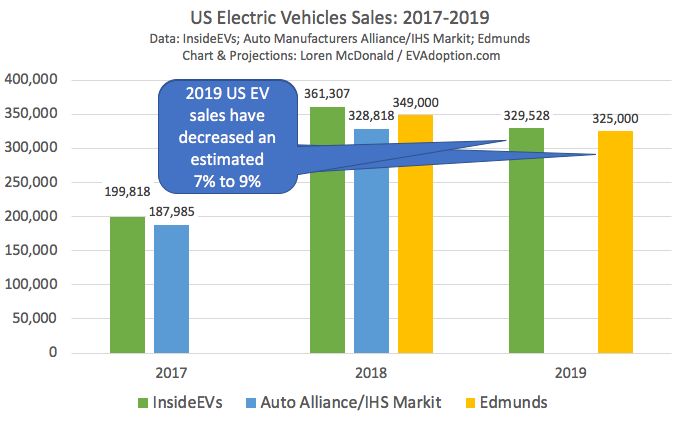
Why Did 2019 Electric Vehicle Sales Decrease?
While the precise 2019 sales numbers using registrations won’t be available for a few more months, it seems pretty clear that EV sales will likely be down between 25,000 to 30,000 units, or 5% to 10% from 2018.
In a January 2019 article I wrote for CleanTechnica, Forecast: 2019 US EV Sales Growth Will Drop To ~12%, I had forecast YOY EV sales growth of 12% in 2019. What I didn’t expect when I developed this forecast a year ago, was that several popular EVs would see fairly significant YOY declines and two new highly acclaimed BEVs would be severely supply constrained.
There are 6 primary reasons for the 2019 decline in EV sales:
1. 2018 Was a Monster Year for EV Sales: Sales of EVs in 2018 were a record 328,818 units (using Auto Alliance numbers), a 74% increase over 2017. (InsideEVs estimated an 81% increase.) Equaling or beating the 2018 sales volume was always going to be unlikely, because of the following additional 5 factors.
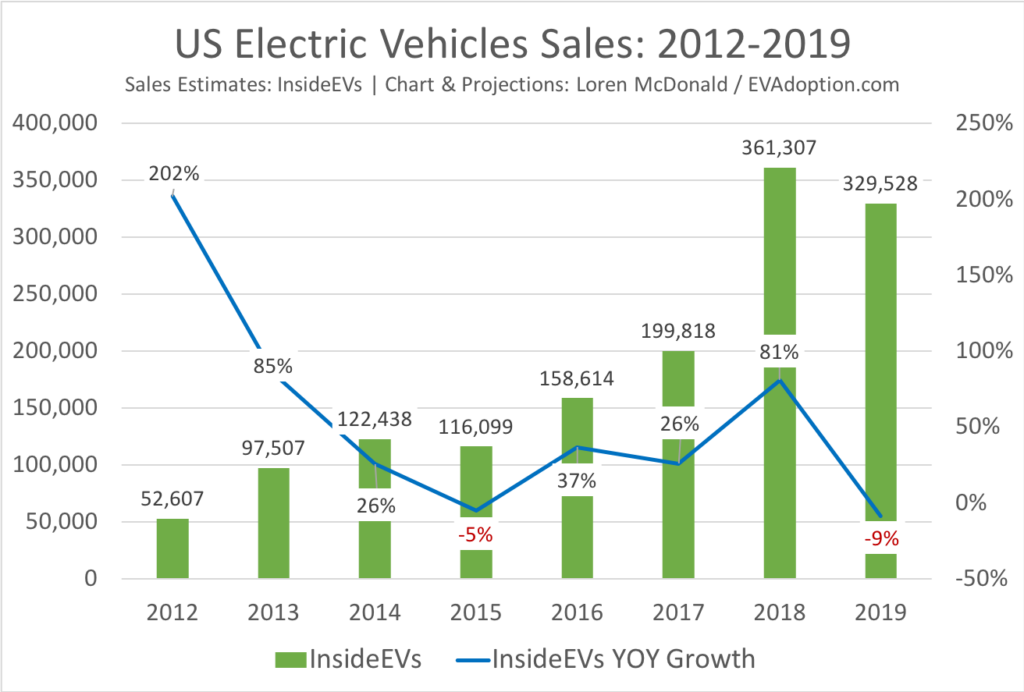
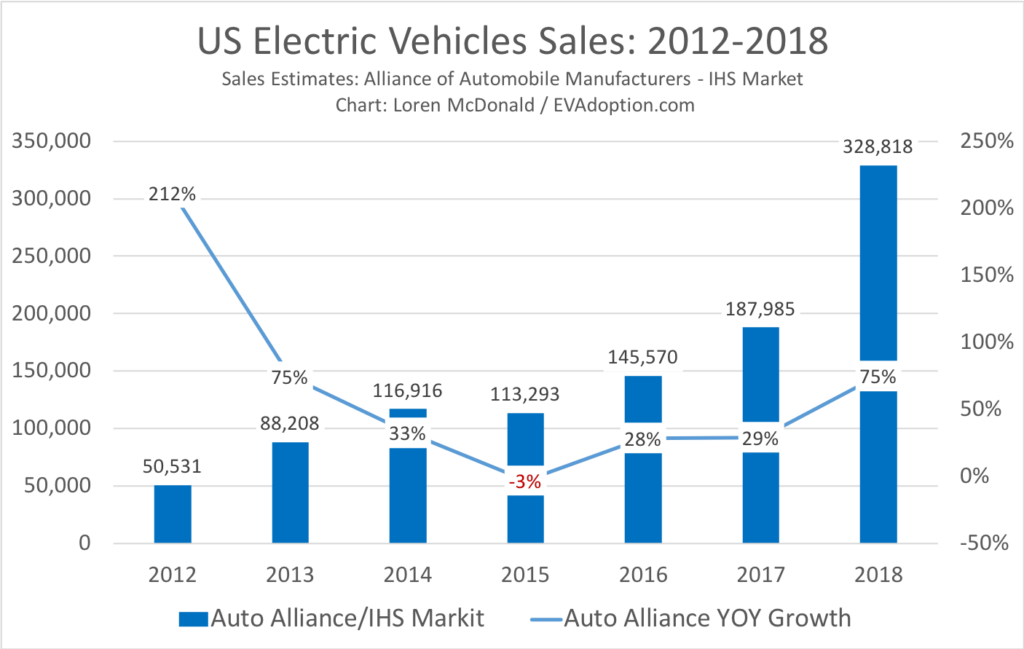
2. Tesla Model 3 Only Had “Modest” Growth: According to InsideEV’s sales estimates, the Model 3 accounted for 38.7% of all EV sales in 2018. InsideEVs’ 2019 estimates peg the Model 3 as accounting for a whopping 48.2% of all US EV sales, but only an increase of 19,143 units over 2018.
Model 3 production and sales scaled up significantly in the second half of 2018 and was always going to be a sales volume level that would be tough to match in 2019. This was especially true in late 2019 many Tesla shoppers were told by sales employees that “every available Tesla was being shipped to Europe.”
The estimated Model 3 increase of 19,143 units is impressive at one level as at that amount of sales it would basically rank an EV in a virtual tie for third with the Tesla Model X. But that volume increase only accounted for 5.8% of all estimated EV sales, which barely put a dent in the near 31% decline in YOY sales among the other top 10 selling EVs available in 2018 and 2019. (See next point.)
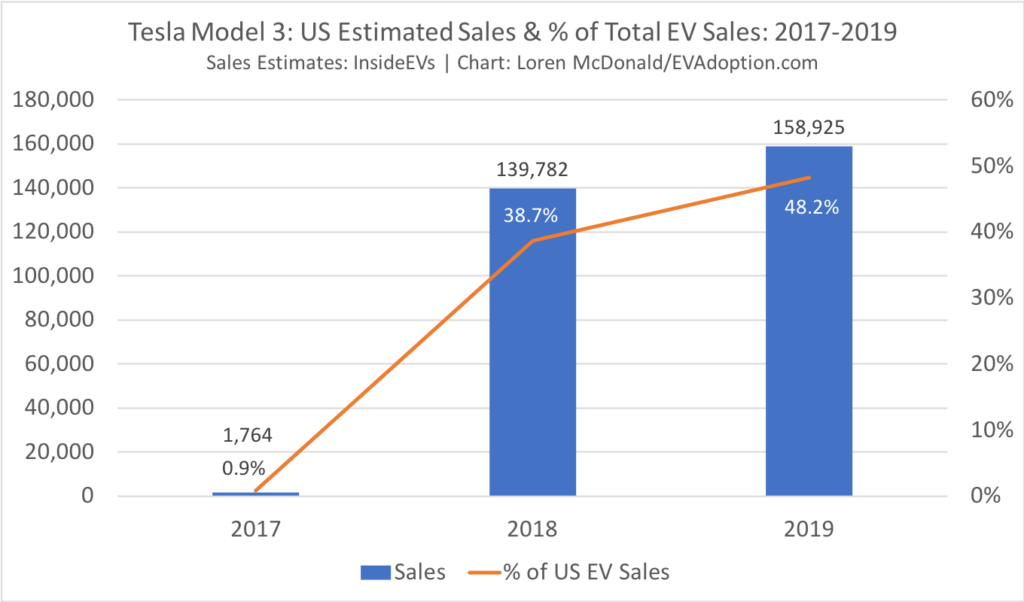
3. Significant Decline Among Top Selling Vehicles: Across the top 10-selling EVs in 2018 as tracked by InsideEVs, sales were down a combined 32,000 or -10.4%. Only the Model 3 had an increase in sales (+19,143) with the other 9 of the top 10 selling EVs from 2018 seeing an average decline of 5,673 or -19.5% in 2019.
If you exclude the Model 3’s sales volume, the number 2-10 selling EVs from 2018 had a combined decline of 51,000 units or -31% in 2019. Ouch. This is particularly significant because these top 10 EVs from 2018 accounted for 83% of sales in 2019.
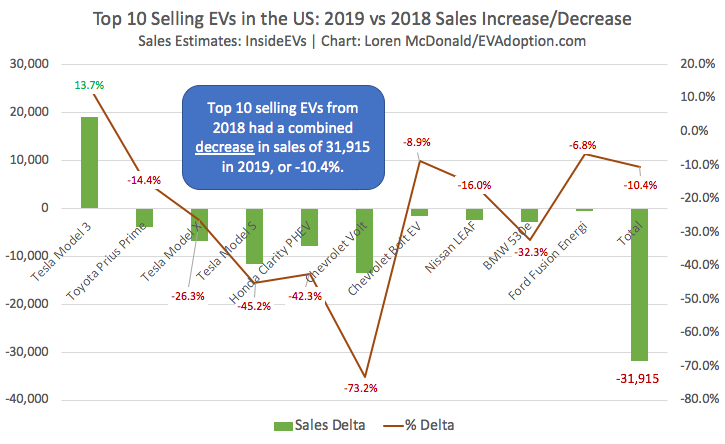

4. Sales Declines for 63% of EV Models: Of the 43 EVs available in 2018 and 2019, 27 saw a sales decrease for a total of -70,841, using estimated sales numbers from InsideEVs. Only 16 saw an increase in sales, for a total of 29,675. If you exclude the Tesla Model 3, sales only increased 10,532 units from the other 15 EVs with YOY growth.
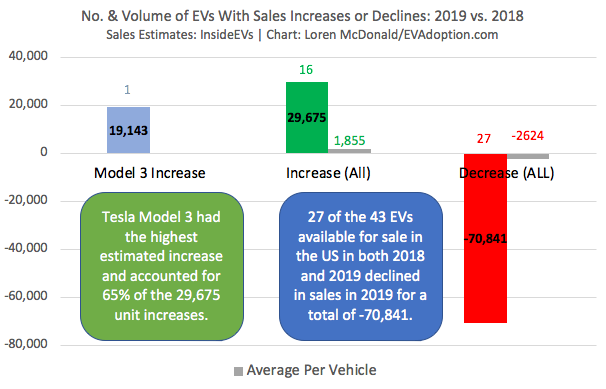
Key contributors to these declines were GM discontinuing the successful Chevrolet Volt (though dwindling supplies have continued), that Honda would make the Clarity PHEV available only in California, and that the Tesla Models S and X, and Toyota Prius Prime would all see fairly significant YOY declines.

5. No New High-Volume EVs Were Introduced: In 2019, only 8 new EVs reached dealers in the US: Subaru Crosstrek PHEV, Kia Niro BEV, Hyundai Kona EV, Audi e-tron, Porsche Taycan, Lincoln Aviator Grand Touring, Range Rover PHEV, and Range Rover Sport PHEV. I’ve estimated that sales of these 8 new EVs only accounted for about 9,500 units, or 2.9% of total 2019 EV sales.
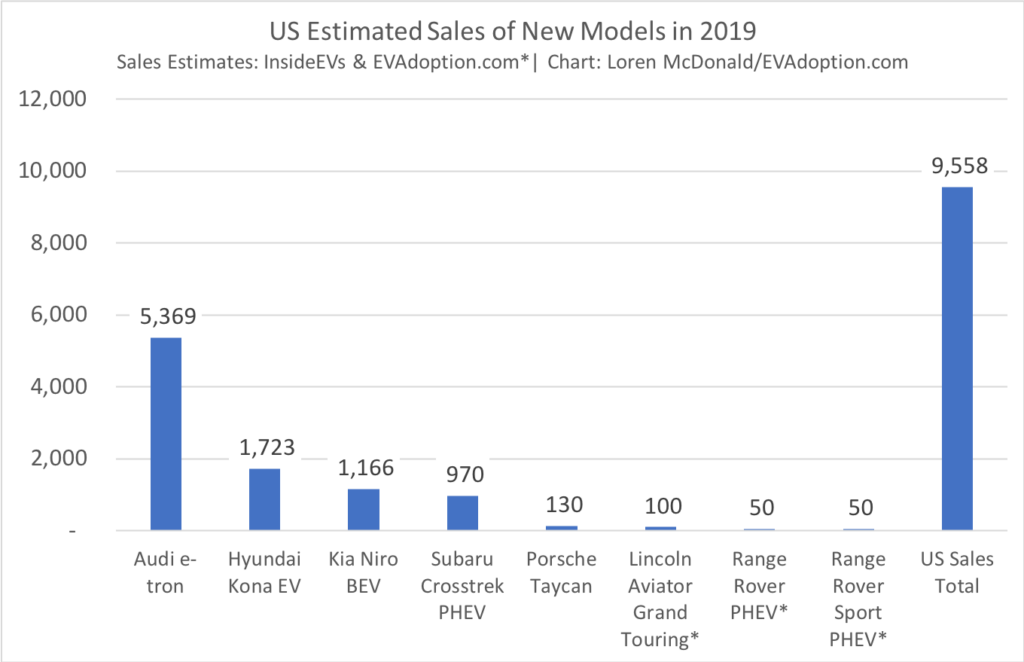
Of these, the Audi e-tron, which became available in April, sold the most units at 5,369. While this volume is respectable for an EV and vaulted the all-electric Audi SUV into 11th place, it is still a rather small volume of cars. The other models were either introduced late in the year and/or only produced in low volume. (InsideEVs has not published estimates for the Lincoln or Range Rover models, so this are EVAdoption estimates.)
As I wrote in the article, New EV Models Responsible For Nearly All Annual US EV Sales Growth – New Analysis, my analysis shows that in recent years, EV sales growth only occurred when new higher-volume EVs were introduced. In 2019, not a single high-volume EV was introduced in the US market.
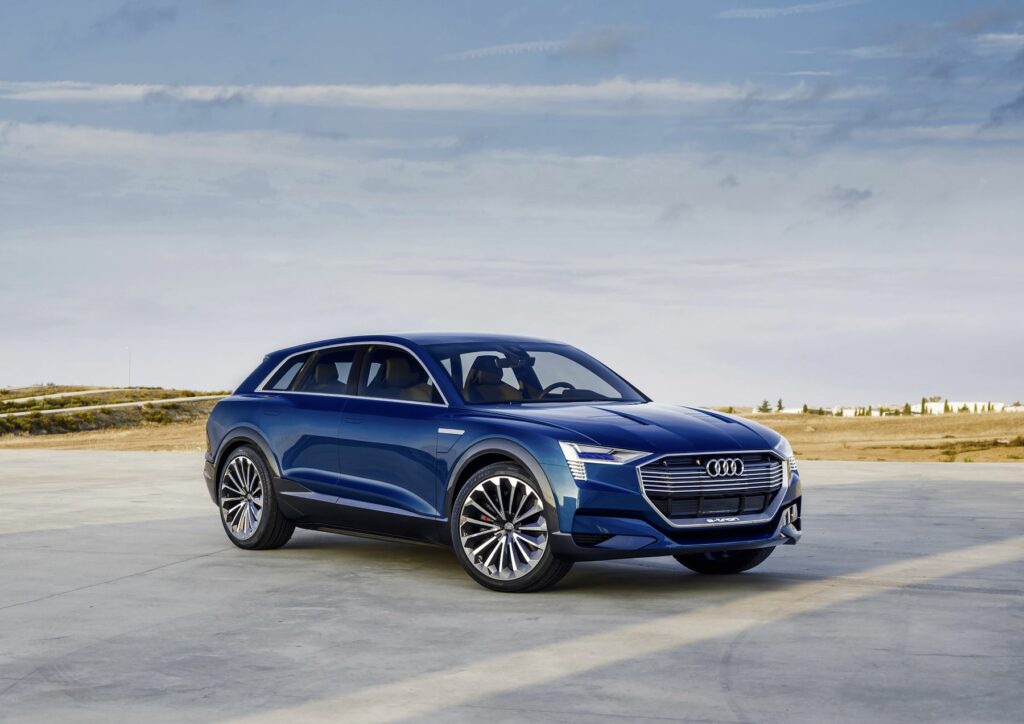
6. Limited Supply and Dealer Availability: Several models with strong sales potential in 2019 were supply limited by the automaker and/or availability was limited to certain states. The most disappointing sales numbers in 2019 were for the highly acclaimed Hyundai Kona and Kia Niro BEVs, which only sold a combined 2,889 for the year according to InsideEVs. These two BEVs combined could and should have sold that many per month if production and availability had not been limited.
The Chevrolet Bolt sold an average 1,368 units per month according to InsideEVs and by most accounts, the Niro and Kona BEVs are better EVs. But both of the South Korean manufacturers said that these models were battery supply constrained and production was being prioritized for their home market and Europe. Even if we assume a similar sales volume as the Nissan LEAF at about 1,000 units per month, the theoretical shortfall potential for the Niro and Kona BEVs would be around 21,000 units.
“California is the largest market for plug-in hybrid vehicles. In order to meet customer demand, we are currently prioritizing supply of the Clarity Plug-in Hybrid in California, rather than allocating units for dealer inventory in other markets.”
Honda spokeswoman Jessica Pawl told Green Car Reports in an email.
Analysis I did in 2018 showed a strong (and obvious) correlation between the number of models available in a state and its EV sales share. US EV sales growth will continue to be hampered with many automakers limiting availability of their EV models to only ZEV mandate or selected states.
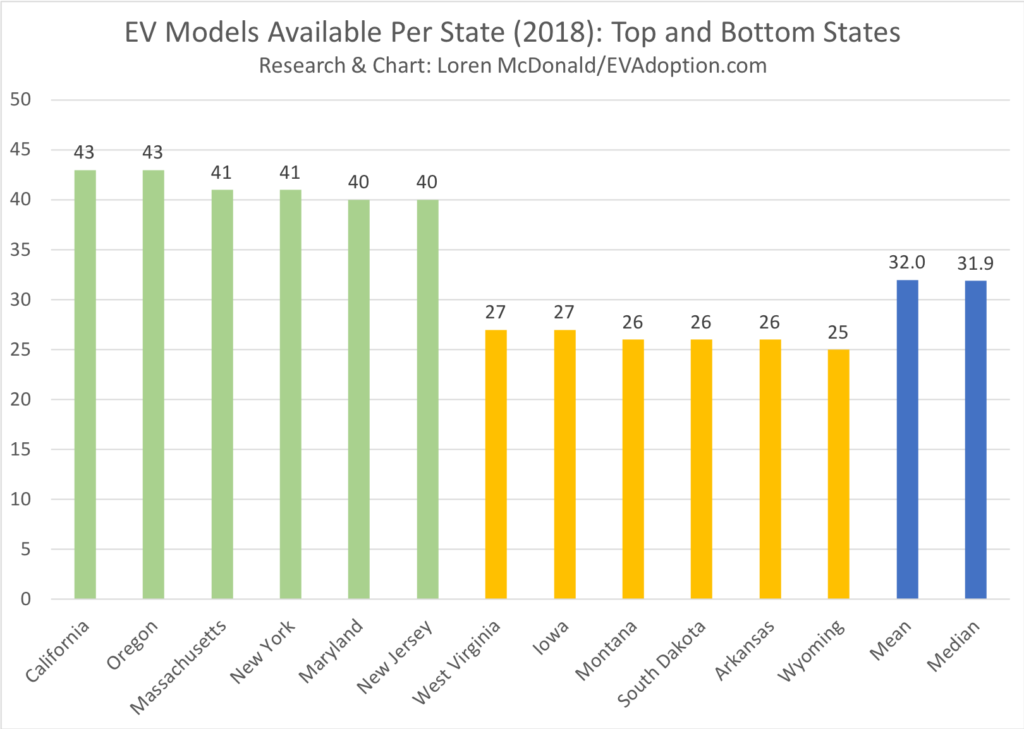
Other Factors That May or May Not Have Affected EV Sales in 2019
US auto sales overall decreased about 200,000 to 300,00 units or less than 1%, but the market being basically flat likely had minimal impact on the sales of EVs.
Secondly, while many analysts point to the phaseout of the Federal EV tax credit for Tesla and GM models, as contributing to the sales decline, I don’t agree. The Chevrolet Bolt only saw a decline of 1,601 units in an increasingly competitive field and the 13,396 decrease for the Volt was a result of being discontinued.
The large estimated declines for the Tesla Model S (-11,645) and Model X (-6,875) are most likely due to buyers opting for the lower price Model 3, waiting for the Model Y, choosing a competitor like the Audi e-tron, and the simple fact that both models are getting relatively old with minimal changes other than the battery pack increases. As I wrote in, Sales Growth of US EV Models Peaks After 3 Full Years on the Market, most EVs have seen their peak sales volume by its second or third year in the US market and both the Model S and X are past this point.
There are at least 24 factors that affect the rate of EV adoption in the US, but the majority of them were not drivers of the decrease in 2019 EV sales in the US. And while some observers believe that the US market has basically tapped out the population of early adopting EV buyers (especially for Tesla models), I disagree and believe as outlined in the 6 reasons above, the primary reason for a slowing in sales is one of supply.
 Announcing the acquisition of EVAdoption by Paren →
Announcing the acquisition of EVAdoption by Paren →
9 Responses
Could I get permission to use the first image showing US EV sales?
Sure, please just source the content.
Do you have a sales forecast by month for the new Audi e-torn GT? Both the regular and RS versions? What will be the impact of these new introductions on the market in Europe and NA? All insight is appreciated…
I don’t yet, but in the US I would suspect 6,000-8,000 annualized. EU perhaps a bit more, but its impact will not be significant from a sales perspective, but will serve more as a halo effect for the Audi brand.